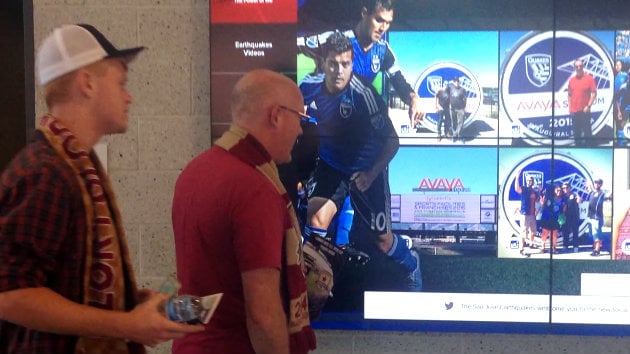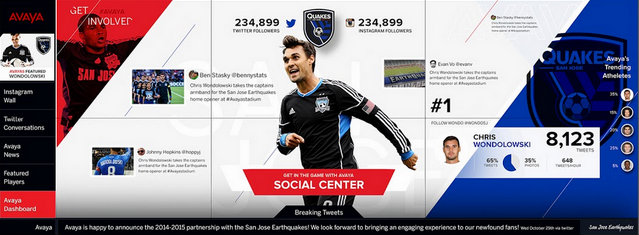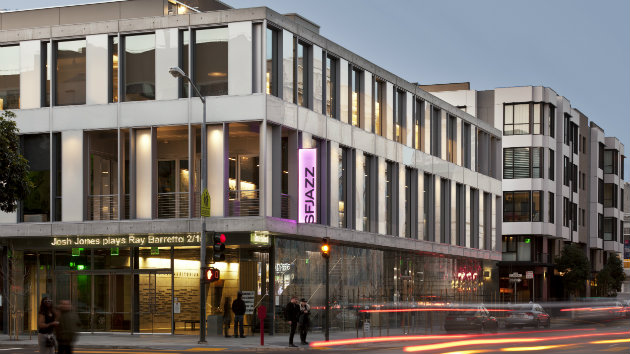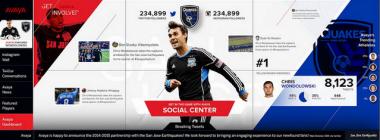
This is the last in a series of pieces about audience development in the performing arts.
Not long ago we went to see “the wall.” This was during a press tour at a San Jose Earthquake soccer game in their new Avaya Stadium, named after the multinational tech company whose products enable “next generation customer engagement.”
Incidentally, while Major League Soccer (MLS) remains at the kiddie table of professional sports, the spectacle that night was both accomplished and, to marketeers in the performing arts, perhaps instructive.
It was Portuguese Heritage night and for a moment the stadium had the feel of a music festival, what with the ethnic dancing and folk music before the game. People picnicked on an acre of lush grass behind a 100-yard long bar, stocked with everything from Dos Equis to Grey Goose. Above the bar, there’s a 55-foot-wide by 25-foot-high screen, blasting interviews with players; their names often included Twitter handles, and so the illusion that one could make personal contact with heroes.
And then there was the wall, an interactive, “fan engagement,” multimedia display screen, about the size of a large Persian rug. There are similar kinds of “signage” around the country, but those walls are invariably preprogrammed or heavily curated. The Avaya wall is “live” and, as one Avaya executive put it, “aggregates social interaction in a way that no social network service on their own can do.”
The wall hangs horizontally, in a high-traffic area and features information about place and players. Once the game starts, it fills up with fan photos and sanitized Tweets, which allow — as one of the marketing pamphlets explained, in what seemed a cheeky way but wasn’t — to get their “15 seconds of fame.”
The wall’s nature brings to mind the monoliths in 2001: A Space Odyssey, those foreboding, black-slab repositories of cosmic intelligence. You could argue that this inter-terrestrial wall is not only a summation of digital knowledge these days, particularly for a new generation that would rather text than talk, but also a metaphor for the way in which technology is being used to expand fan engagement.
Whatever the wall’s nature — it may be closer to a totem pole, and always it’s a marketing device — Avaya insists it’s coming, in some form, to hospitals, airports, schools, companies, and stadia, and finally, perhaps, to the concert hall, which raises that relentless question for the performing arts: How do you modulate the effects of technology so that organizations, artists, and audiences remain on equal footing with technology itself, as well as with the companies that provide it? And who will — and who should — have the final say about whether a particular product or protocol is suitable to a particular art form: the presenters, the artists, or the audience?
In sum, who should protect the integrity of the concert hall? And how.
Till Partnership Do Us Part
In addition to the fan engagement wall at the Earthquakes’ stadium, Avaya also provided indoor and outdoor internet access points; Ethernet routing switches; an “identity engine” for security; a mobile app; and a teleconferencing system. In sum, Avaya’s partnership with the Earthquakes traded a new stadium, wired to the teeth, for a way for Avaya to experiment with new technologies and, at the same time, develop fresh marketing possibilities.
“The relationship with the Earthquakes is not just a sponsorship,” said Andy Steen. “They don’t want us to just come in and throw a lot of money at that.”
Steen is head of the Sports and Entertainment Group at Avaya; her job is to seek out strategic partners and “create co-marketing opportunities.”
Another Avaya wall is up at the Pepsi Center in Denver, and there are plans for more walls, both in this country and abroad.
She added, “Every single one of our sponsorships has to be a showcase for our technology. If it doesn’t meet that criterion, it’s not a strategic sponsorship for us. It has to have our technology imbedded, they need to be using it, and with that we can grow their fan engagement …”
It’s a matter of “shared values," she added.
The Veil of Virtuosity
It would appear that the long-term agenda at Avaya, and other similar companies which focus on performance of one sort or another, is not merely to build ever more fanciful fan engagement walls, digital infrastructure, and apps; it’s to redefine the very meaning of engagement. Part of that redefinition includes exploring the attraction of data-driven measurement, which seems to be particularly compelling for people under 30.

For example, the NFL is putting small, battery-powered beacons in player shoulder pads, each transmitting 12 pings a second to shoe-box sized receivers placed around a stadium. It’s a new way to quantify and analyze the game, and of use to play-by-play broadcasters and trainers alike. Steen believes these kinds of applications will soon find their way to the arts.
“I think that’s going to extend to artists at some point. We’re going to measure things that will help fans connect better with individual musicians or dancers. And as we define what we want to measure that will only create more connections to the fans.”
“We go to be emotionally connected to them,” she added, referring to performers, “and if we can do that through technology, that allows us to have more of an emotional connection.”
One might argue this is all part of an effort to penetrate the veil of virtuosity, to switch the emotional connection— in the context of music — away from notes to code; from the experiencing of music to the sciencing of music; all the more to bedazzle us with the biology and physics of leaps, voice range, and bow speed, so that talent will have that much more luster and wow.
SFJAZZ and the Opt-out Button

Among Avaya’s partnerships is SFJAZZ, with its $64 million jazz center, which opened in 2013 — the "first free-standing building in America built for jazz performance and education.” SFJAZZ presents more than 300 performances a year and claims to be the world’s preeminent cultural institution devoted to jazz.
SFJAZZ partnered with Avaya last February, and since then Avaya has installed a state-of-the-art phone system and new video technology to enable “two-way distance learning.” Recently, SFJAZZ streamed a live jazz concert featuring the SFJAZZ Collective. The broadcast was directed exclusively to four locations of the San Mateo County Library.
Avaya threw out an offer to install a wall, but SFJAZZ, as happy as they are with Avaya’s other technologies, declined, in part because they already have a video wall that offers rotating slides. Though not state-of-the-art by comparison, that wall suits their needs.
We spoke to Don Derheim, the CEO of SFJAZZ and before that, Chief Operating Officer and Executive Vice President at KQED, the PBS member station in San Francisco. He had gone on a press tour of Avaya stadium himself and seen the wall.
“It’s really something,” he said. “And yes, I could see walls like that at a music festival, where there are multiple pulls on your attention, and here’s something with a lot of information and also demanding your attention. But I think you always have to ask the question, ‘how is this kind of thing related to the art form?’ ‘Is it part of the art?’ And if the answer is yes, then perhaps in some settings, it might be like part of the set. If this were on a par with supertitles, that would be one thing, but for our audience it doesn’t necessarily bring the performer closer.”
Derheim’s abiding interest is in “liveness,” a core value of SFJAZZ’s founder and Executive Art Director, Randall Kline, whose objective from the start has been to make a live performance convey the sense of intimacy and community that you might feel sitting around a campfire.
Nevertheless, Derheim unabashedly embraces technology and foresees a time when a worldwide audience could attend a live, digital, jazz performance with an analog feeling of being around the campfire.
“I can imagine that,” he said. “It’s something we hope to be able to do at some point. Certainly, we are investing in tech to be as creative as possible; we’re experimenting with both hardware and software. It’s all part of our mission to bring more jazz to audiences around the world; to establish little SFJAZZ hubs through which we can plant clubs, seed jazz musicians and jazz admirers, and build communities around our art.”
But exactly what should be the role of technology in all this? Derheim is cautious.
“Clearly, the nature of any partnership is that both sides be willing to give in to get what they want. Here, the trade-off for the technology is that we benefit from new customers, members, donors, and artists. But at the same time — and I mean this generally; I’m not referring to Avaya — whenever you enter a partnership, you don’t want to be used. The measure of our integrity as an organization must be that when we need to stand on our own two feet, we can and we will, and if need be, remain quite stubborn. If a partner wants to do something that will affect the audience or the artists in a way they’re not ready for, we must be willing to say, ‘no.’ The audience needs to want the technology first, not the other way around."
The Wall’s Significance
At the end of the Avaya Stadium press tour, there was a silver-terrined, buffet dinner. At a table filled with Avaya marketing reps the discussion turned to how sports has, and has not, adapted to new technologies. Basketball is in the forefront of change; baseball is trailing. One marketer claimed the average person watching baseball on TV these days is a 53-year-old, white male.
Among those at the table was David Chavez, a VP in Avaya’s Chief Technology Office. The significance of the wall, he told us later in an email, is about more than the volume of social network traffic it manages: “It’s about the communities it is normally shared with (friends versus the world), it’s about the fact that different people use different social networking services (Facebook versus Instagram for example), and that the service focuses on what the venue operator wants to portray or find acceptable as opposed to raw feeds. The nature of the Engagement Wall technology also gives the operator insight to guests digitally and socially that can be used for marketing purposes. So the characteristics in question are rather complex.”
As an aside, Chavez was once an avid bridge player and achieved the rank of Life Master. But then he stopped playing. “What I found over time is that the bridge community was rather insular, and while some greatly welcomed the youth into the community, others preferred that we stay away and began legislating innovations we started bringing to the game. Entering into a major tournament, being told an hour in, that the system my partner and teammates were using was not allowed — when in fact it was, but there is no recourse while you are in the tournament. That was the last straw for me.” "Classical music is best appreciated at the symphony or on a high-end sound system. (But) you don’t see many at the first and you don’t see many buying the second. Without attention paid to this the outcome you fear will happen on its own.” - David Chavez, VP in Avaya's Chief Technology Office
Chavez went on to say that classical music
“may not suffer from exactly the same malady but it may be a melody. Bridge didn’t attract a younger audience because it failed to allow innovation, and there was little interest in genuinely solving the generational issues. I see something similar in classical music: there are newer artists that do not get enough exposure or support — I would point you to Bear McCreary as a modern artist deserving more recognition. The venue has to compete with video games and time in social networks to get the attention of the younger listener. Classical music is best appreciated at the symphony or on a high-end sound system. (But) you don’t see many at the first and you don’t see many buying the second. Without attention paid to this the outcome you fear will happen on its own.”
“The Long View”
One of the symbols of corporate culture at Avaya is the “red thread,” a metaphor for the nature of connectivity. Steen explained the concept in an email: “The red thread comes from an old Chinese proverb; it’s the proverbial thread that connects ideas, culture, and themes within a single company. From a partner perspective, we view partners as an extension of our own company—connected by the red thread—and working ‘better together.’”
The knotty part here for performing arts organizations is the idea that partners should become extensions of Avaya, share Avaya values, and along the way become Avaya marketing vehicles. But at first glance, the suggestion of subservience aside, you might think, ‘well, but that’s a reasonable business goal, and clearly the arts need to innovate; what’s the problem?’
The problem is partly the question of artistic relevance, as Don Derheim pointed out. But there’s also the murkier problem of the way in which the fan wall — literally and metaphorically — may change the nature of an artistic performance, as well as the expectation.
The wall may be a natural addition to a sports environment in which fans are bound together by a team’s identity (no-soul searching required). The wall may also be a marvelous addition at a political convention; an amusement park; or an airport, where an engagement wall might aggregate news footage from around the world, along with public reaction. Or at a rock concert, where fans are bound together by mood and music, and where the need to share, to be ‘social,’ is overpowering and now a commonly accepted convention.
After all, this is the on-demand generation that prefers to text more than talk, even if in the same room, and always a response is required. It’s all in pursuit of the “perfect conversation”, as MIT social studies of science professor Sherry Turkle put it on Science Friday recently: To have an edited version of themselves in play at all times.
“Yes,” said Chavez, “I find this bizarre, but it is not really debatable. Conversation as defined by this generation is now different. Being in the moment is what they seek, and their communities are largely digital.”
This is the heart of the muddle: For the performing arts world, which conversation is of greater value, the one among members of the audience or the one between the audience and the performers? Or the one between the individual and his or herself. Can all these conversations coexist, and, as a new audience defines itself, must the presenter offer all the conversations to be financially viable?
Perhaps the answer lies in one’s definition of “liveness” which, to my mind, defies filters: including the desire to share, comment, photograph, or otherwise possess. After all, who could go to a concert hall and listen, really listen to, say, Gorecki’s Symphony No. 3, and afterward, or during, post a message or a selfie to the symphony wall? And even if Dawn Upshaw were backstage and somehow, unimaginably, willing to appear on the wall to take questions, what would you want to ask her at such a moment? What would there be to say?
In the end, what’s the value of this kind of live experience and how should it be protected, and what would it mean if it were lost or undermined?
Technology may enhance liveness, make it more accessible, but it isn’t required. This is the gravity pull of the campfire — the concert hall or theater — where liveness is simultaneously private and communal, archetypal and current, and finally, one hopes, a source of freedom and revelation.
But….
“We’re on the long road” said David Chavez as we walked around Avaya Stadium. He was referring, at least in part, to Avaya’s quest for supremacy — said not imperiously but rather with a tone of inevitability. The worry in the silence that followed was that corporate power, along with red-thread marketing assumptions, the lure of ‘shared values’, the weight of technology itself, and the lack of strong leadership in the performing arts will eventually confound the ‘opt-out button’, and for better and for worse, come to dominate this sector of cultural expression and sensibility.

